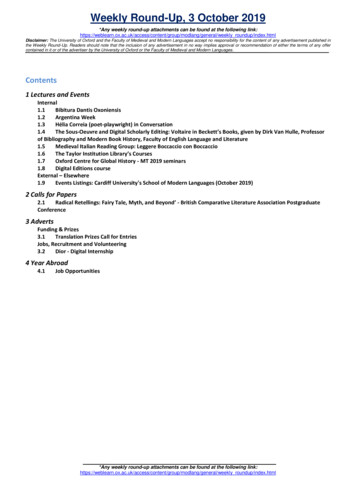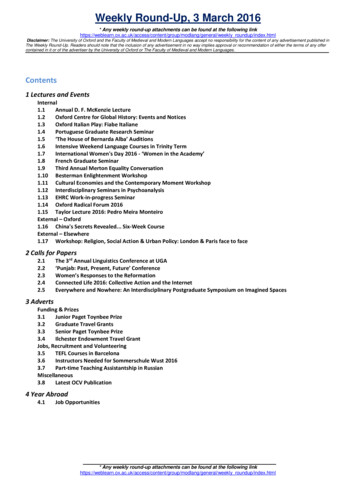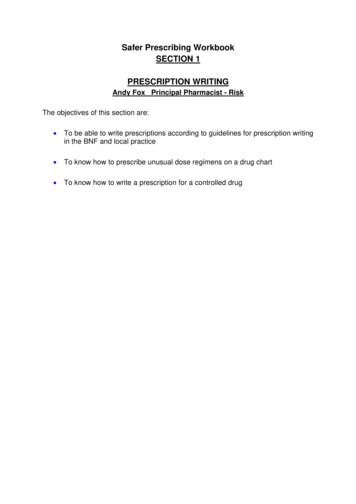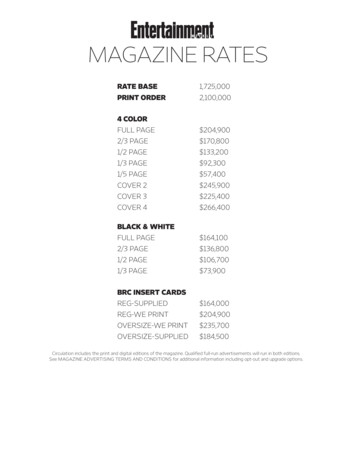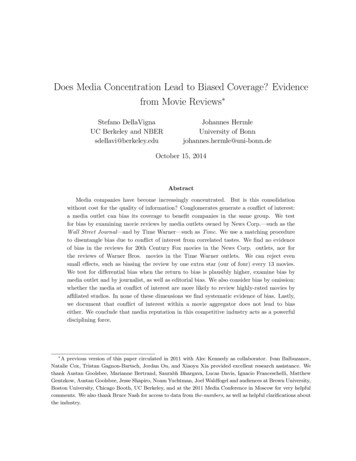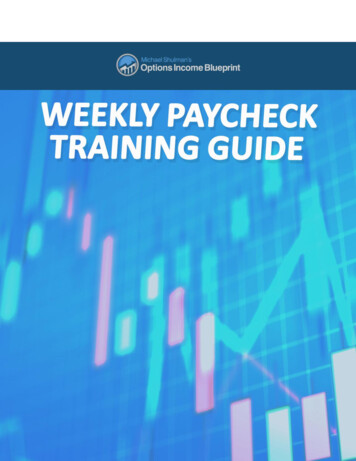
Transcription
How to Supersize Your Weekly Options Trading ProfitsOne of the biggest innovations in the option-trading field over the past decade has beenthe growth and acceptance of Weekly Options. Most of these are provided by theChicago Board Options Exchange (CBOE), which is the world’s busiest optionsexchange.What are Weekly Options and how do they differ from normal Monthly ExpirationOptions? As you may be aware, normal Monthly Options are issued on a quarterly basisfor each stock, ETF or index. There are different cycles of expiration so some, but notall, options are on a January/April/July/October expiration (also known as “JAJO”options). The other 2 main cycles are February, May, August and November as well asMarch, June, September and December.But these aren’t the only monthly options available, as you may have noticed in yourtrading. There is always a “front month” expiration option and a “second month”expiration option. In addition, many of the more liquid securities have Long-Term EquityAnticipation Securities (known as LEAPS) that extend out to January of the followingyear or multiple years into the future.While there generally will always be a front month and second month option available totrade on any particular security, sometimes the closest expiration will be 20 or moredays away. For a shorter-term option trader, this means that there is a great deal of timepremium in those options. Time premium is basically made up of time decay (Theta)and implied volatility.For an option buyer of Calls or Puts, this time premium can often act like a “tickingclock” against the profit potential of their position. Each day that elapses, time decay
erodes from the option’s value. In addition, there is risk in implied volatility going up ordown and changing the option’s value.Therefore, one could look at Weekly Options as an alternative to get more “bang foryour buck” in options trading. These options, which have been growing in popularityover the last number of years, are generally issued/listed on a Thursday morning andexpire the following Friday. The shorter life cycle of these options means that the timepremium in their pricing (and their time decay) is less than a normal monthly option.See the table below for the typical issuing schedule:The growth and ever-increasing availability of Weekly Options has acted as a gamechanger for short-term options traders. At BigTrends.com, we focus on short-term,active, technical analysis-based trading, a combination of factors that can boost ourclients' profits across more trading cycles.For option buyers of calls and puts, this represents a great way to get the leverage ofoptions without paying as much in time premium. The Delta on these Weekly Optionswill in many cases be higher than a corresponding Monthly Option, giving us supercharged profit potential on our trade recommendations.One of the meanings of the Greek “Delta” in terms of options is that it indicates howmuch an option will move on a 1.00 move in the underlying security. So, if we aretrading a Weekly Option with a Delta of 60 and the corresponding Monthly Option has a
Delta of 50, the Weekly Option will gain value quicker when the stock moves in ourdirection.Also, the Weekly Option will often have a much lower actual dollar cost than theMonthly so in this theoretical example, a 2 move in the underlying stock means a 1.20 move on a 3.00 Weekly Option, giving us a quick 40% gain. Let’s say theMonthly Option was 4.50. With a 1.00 move in the option, our gain is only 22%.Of course, this enhanced leverage can work against us too, which is why BigTrends’timing methods are so valuable to active traders.With this big decrease in Theta and time premium on the Weekly Option, the leverageof these short-term vehicles becomes even more significant when compared to outrightstock buying. This means less out-of-pocket cash to you as an option trader whilestill providing the potential for big gains.We love how Weekly Options can capture quick-fire profits in this volatile market. Withour state-of-the-art technical analysis indicators, we can catch big in-and-out moves in avery short time frame. And that’s not to mention the volatility around earnings reports,news announcements, Fed meetings, takeovers and other market-moving events!Weekly Options also offer a premium-selling, income-generation element that manytraders find attractive. Out-of-the-money options have a very rapid time decay, whichmany traders prefer for option-selling strategies such as credit spreads and otheroptions combinations.Click here to view the current Weekly Option offerings from the CBOE; new ones areadded all the time and even event-specific options can be added. You can see thatmany of the biggest, most popular names are already actively trading and more areadded all the time.
What about liquidity? While it was once the case that Monthly Option volume dwarfedthat of Weekly Options, the growing popularity of Weeklies has leveled the playing fieldin terms of liquidity. Take a look at the CBOE’s table of Weekly Option Volume on theS&P 500 Index (SPX):This is an upward trajectory that is similar to the growth of options trading volume itselfover a longer time frame.
And the availability of quotes and trading on Weekly Options is simple and quick. Theoption brokerage specialists that we use for our auto-trading clients have easy accessto trade these options. Check the PayPal (PYPL) option matrix from thinkorswimbelow, which combines the Weekly and Monthly Options on one easy-to-readscreen.Note the big volume and the narrow bid/ask spreads on the Weekly Options – thespread on the bid/ask is already the same as the Monthlys, so we don’t give anyunnecessary edge to the market makers!
The Weekly Options Accelerator Trade Alert ServiceThere are many ways to trade options and at BigTrends, we prefer to keep it simple andeffective to capture short-term trends in quick-moving stocks with the leverage ofWeekly Options. We send real-time trade alerts to buy options on any of our favorite 6stock names (M, CGC, PYPL, WTW, NVDA and GOOS), typically at the end of agiven 30-minute time period during stock market hours, between 10:00am to 4:00pmWall Street time.Let’s look at a couple of case studies to show you the potential of these quick trendswith weeklies but first, it’s time for a quick lesson on one of our favorite trend followingindicators.Directional Movement Index and Average Directional MovementOur main method to find the sweet spot for entering Weekly Options Acceleratortrades is to focus on Directional Movement Index (DMI) lines and, in particular, how theywill interact to show us the Average Directional Movement (ADX). And while the ADXreally separates the wheat from the chaff, knowing about DMI lines and adding amoving average to filter out the noise is crucial to see the full picture.We’ll start with the DMI lines. They were developed by Welles Wilder (who alsoinvented the RSI indicator) to identify a stock’s movement or “True Range.” Whenlooking at a typical bar chart, this encompasses not only the high-low daily range of astock but also any upside gaps the stocks may have had from day to day. And bydrawing a dotted line from the prior day’s close to the next day’s high, you’re findingwhat he called the stock’s “True Range.”The True Range is by definition either the same or higher than the daily high-lowrange, since the upside gap won’t allow it to be lower. And with gaps added to dailyranges, you can take these True Ranges and create an average over time to show howmuch total movement (including gaps) is happening in a given time period.From a directional movement perspective, the DMI lines are there to show us that weare making higher highs, with positive directional movement increasing. If we’re makinghigher lows, negative directional movement is going to be moving down. And a channelmaking higher highs and higher lows is the very definition of an uptrend. This thenallows you to clearly define when you’re in a trend phase versus when the ADX is notgoing up, which would signify more uncertain, range-bound action.While nothing is certain in the markets, getting a good ADX confirmation signal willincrease our edge and thereby allow us to win bigger and lose smaller. And thistruly is the secret of the trend trading game, no matter what vehicle you trade.Now, let’s look at a recent bull and bear example so that you can learn to see thepatterns to look out for in order to really catch and ride these quick-moving stocks
Canopy Growth (CGC)As you can see from the chart above, cannabis leader Canopy Growth (CGC) is nostranger to making new highs. CGC gapped to the upside on the morning of January25th, 2019 and it’s often these starting gaps that create a strong pull in the ADX to starttrending up.This is especially powerful when coming from a period of no trend (that is, a very lowADX) right before the gap. In the chart, you can see the DMI (blue), DMI- (red) andADX (green) in the bottom panel. You can also see our moving average filter as theblack line below the circled entry point on the top panel of the chart. It’s also worthpointing out that everything we do with our Weekly Options Accelerator tradingsystem is predicated on using a 30-minute chart.From the chart, you can see the DMI- line moving down and the DMI moving up, whichis a clear indication of an uptrend. However, the green ADX line is most important.While it may make sense to wait for the ADX to get high to enter a trend trade, we’vefound that waiting for ADX to surge before entering typically means missing ahuge chunk of the move. What’s worse is that you not only miss the majority of themove, you run the risk of getting hit on a gap in the wrong direction if the trend reverseslater.What we want to see in the setup is a low ADX. You can see that before the big movethe ADX line was hovering below both of the DMI lines. And what we are watching for isthat moment when it starts to turn up. However, you can’t buy every little upturn on ADX– you need to wait until the green line crosses above whichever DMI line is declining.
And we get our buy signal at the circled point above. While it may look like we’vemissed a portion of the move before entering, this confirmation gives us the confidenceto catch the larger part of the uptrend. As the old adage goes, “for a stock to go from1 to 100, it has to go from 1 to 10 first.”And in our analysis, we think this ADX cross is the trend proving itself as a launch pointat the start of a larger move, rather than an ending point. Once this style of move getsgoing, it can almost coast on its own momentum and CGC continues upwards after ourentry with the ADX continuing to drift higher.But all good things must come to an end and our exit occurs when the ADX rolls over,which we have outlined in a box on the chart. While you might think that exiting whenthe blue DMI line crosses below the ADX, you can see that doing that would cost you adecent chunk of upside. By waiting, we get out of the 42.5 Call with the stock at about48.50. It rallied almost 2.50 points or (roughly 5%) but due to the leverage of usingWeekly Options, we turned it into a 43% gain. And that shows you the power ofusing Weekly Options as a stock substitute, with a healthy leverage ratio of morethan 8-to-1.
Weight Watchers (WTW)Ever since Oprah Winfrey bought a big stake in Weight Watchers (WTW), thestock has been cast into the high-growth spotlight. But with higher-growth stocks,you often see not just big upside potential but also a steady run for the exits when thetrend goes the other direction.In the chart above you’ll notice WTW shares were already starting to drop with thebreakdown below the moving average filter in black before our official bearish entrysignal. But with options buying, your bigger successes will come from catching theincreasing speed of movement in the trend.Here, WTW shares started to break down harder late in the session on February 6th,2019, and the Weekly Options Accelerator alert recommendation went out to buy the35 puts when the stock was already trading near 31. Remember, a put gives you theright to sell the stock, in this case at 35, when the stock is already at 31. That’s called 4points “in the money.” The focus on in-the-money options gives us more of a true stocksubstitute, which creates more stability in how the option premium will perform for evenrelatively small moves in the stock.You can see that WTW kept dropping the next day, though the second half of oursecond day in the trade is relatively flat. But since the green ADX line was still goinghigher, it said that the downtrend was still in place for WTW. So we held it and thencashed out the next morning when the option hit our 100% profit target.
Sometimes the trade could go even further in our favor but we’ve found that it’sgenerally a good idea to book the 100% target profit than to keep riding the trade as therisk of a reversal increases. We’d rather lock down the doubles whenever we can andmove on to find the next low- risk ADX trend getting started elsewhere.Another point to note is that we always stay away from super high-volatilitysituations, so we do not use this strategy when we're coming right into earnings.Trading any stock right before earnings will result in much higher time premium in thestock due to the expected earnings move, something which crushes your potentialleverage.To avoid this, we try to either get into the Weekly Options expiring the week beforeearnings or we'll just wait for those earnings to be out of the way and for the stocksto return to their regular levels of volatility. You basically want to focus on strong trends,use in-the-money options where possible and give yourself enough time to make surethat you don't get crushed by time erosion. These simple rules allied to the catalyst thatis our ADX cross and you’ve got the ultimate system to trade Weekly Options on activestocks!For more information on the Weekly Options Accelerator alert service, call us toll-freeat 1-800-BIGTRENDS (800-244-8736) or email us at clientcare@bigtrends.com.
The Weekly Options Accelerator Trade Alert Service There are many ways to trade options and at BigTrends, we prefer to keep it simple and effective to capture short-term trends in quick-moving stocks with the leverage of Weekly Options. We send real-time trade alerts
